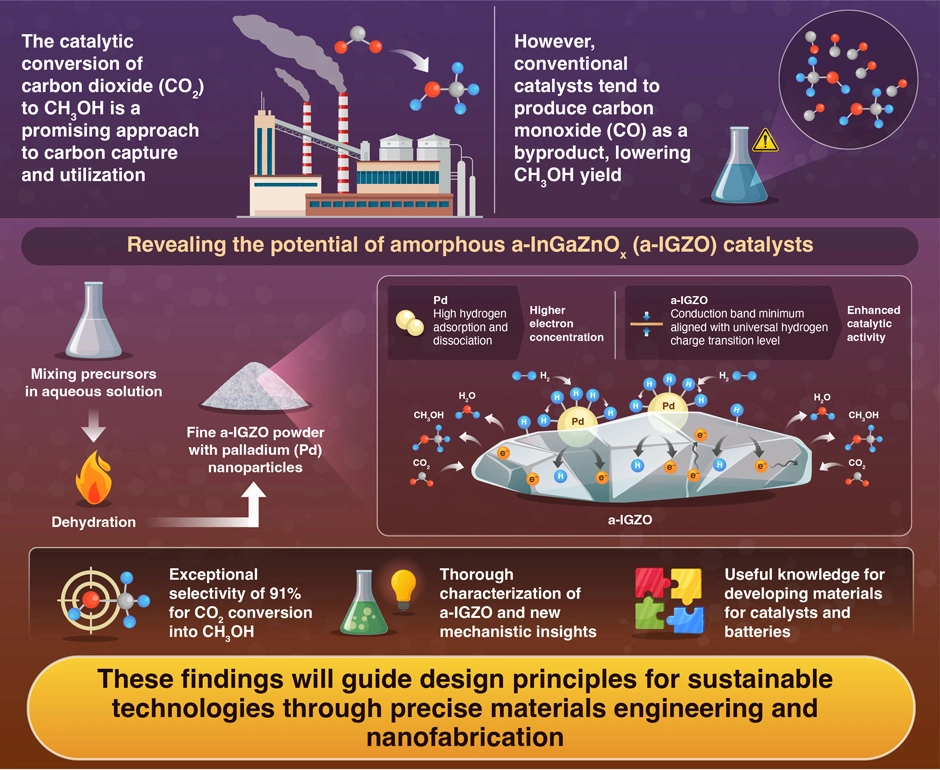Semiconductors show promise for efficient carbon capture and utilization
Innovative catalyst design enables the selective conversion of carbon dioxide into methanol
A new palladium-loaded amorphous InGaZnOx (a-IGZO) catalyst achieved over 91% selectivity when converting carbon dioxide to methanol, report researchers from Japan. Unlike traditional catalysts, this system leverages the electronic properties of semiconductors to generate all the species necessary for the conversion reaction. This study demonstrates novel design principles for sustainable catalysis based on electronic structure engineering.
Designing Semiconductor-based Catalysts for Methanol (CH3OH) Production

Fukumoto et al. (2025) | Journal of the American Chemical Society | 10.1021/jacs.5c03910
The global push for carbon neutrality hinges on our ability to not just capture carbon dioxide (CO2), but also transform it into valuable resources. One of the most promising avenues is converting CO2 into methanol (CH3OH), a key building block in the chemical industry and a potential clean energy carrier in a hydrogen-based economy. While this route offers a compelling pathway for reducing greenhouse gas emissions while creating value, its implementation still faces technical challenges.
Conventional catalysts for CO2-to-CH3OH conversion, such as those based on copper-zinc oxide systems, suffer from poor selectivity. They tend to produce undesirable carbon monoxide (CO) as a byproduct, which lowers CH3OH yield and undermines both efficiency and environmental benefits. This has prompted researchers to explore strategies beyond conventional catalyst design, leveraging the intrinsic electronic properties of semiconductor materials.
In a recent study, a research team led by Professor Hideo Hosono from the MDX Research Center for Element Strategy at Institute of Science Tokyo (Science Tokyo), Japan, presents a novel approach to overcome current limitations. Their findings, which were made available online on June 16, 2025 and published in Volume 147, Issue 26 of the Journal of the American Chemical Society on July 02, 2025, reveal how n-type oxide semiconductors can be engineered into highly efficient catalysts for CO2-to-CH3OH conversion. This work was co-authored by Professor Masaaki Kitano, and Assistant Professor Masatake Tsuji, also from Science Tokyo, and conducted in collaboration with Mitsubishi Chemical Corporation.
The researchers focused on amorphous indium-based oxides, particularly a-InGaZnOx (a-IGZO), which is widely used as a semiconductor to drive pixels in display technology. They synthesized fine powders of these oxides to maximize their surface area—a crucial factor for catalytic activity. Then, the team evaluated the catalytic performance of the synthesized materials, both independently and when loaded with palladium (Pd) nanoparticles.
The key breakthrough came from understanding how the electronic structure of these semiconductor catalysts drives the desired conversion reaction. Unlike traditional catalysts that rely primarily on surface chemistry, the a-IGZO system features unique electronic properties. Specifically, its conduction band minimum is aligned with the so-called ‘universal hydrogen charge transition level (UHCTL),’ which is the energy level in a semiconductor where H+ and H− ions are equally stable. UHCTL is located at ~4.5eV from the vacuum level.
This alignment allows the catalyst to generate both positively and negatively charged hydrogen species simultaneously, which are essential for the multi-step process of converting CO2 into CH3OH. Moreover, the Pd nanoparticles serve as suppliers of hydrogen, dissociating hydrogen molecules into atomic hydrogen(H0) and transferring them to the semiconductor surface. High carrier concentration in oxide semiconductors facilitates H0 tunneling through the Schottky barrier of the Pd/semiconductor interface.
Thanks to these mechanisms, the Pd-loaded a-IGZO catalyst achieved over 91% selectivity for CH3OH production—a notable improvement over conventional systems. “Our work shows that realization of bipolar state (H+ and H− ) of hydron is a key to efficient and highly selective methanol synthesis from CO2, and the design principle for the catalyst is to choose n-type oxide semiconductors with conduction band minimum close to UHCTL, and high carrier concentration,” says Hosono.
Overall, the proposed semiconductor-based approach could mark a paradigm shift in catalyst design, moving from traditional strategies focused on surface chemistry to new ones based on electronic structure. “Our findings not only demonstrate the effectiveness of utilizing electrons, holes, hydrogen species, and their dynamics within semiconductors for CO2 hydrogenation, but also suggest new design guidelines for chemical devices such as catalysts and batteries,” concludes Hosono. These findings will hopefully accelerate the development of more efficient carbon capture and utilization technologies.
Reference
- Authors:
- Kazuki Fukumoto1, Hideto Tsuji1*, Masatake Tsuji2, Masakazu Koike1, Kohei Takatani1, Masahiko Shimizu1, Masaaki Kitano2, and Hideo Hosono2*
- Title:
- CO2 Conversion to Methanol by Hydrogen Species on n-Type Oxide Semiconductors
- Journal:
- Journal of the American Chemical Society
- DOI:
- 10.1021/jacs.5c03910
- Affiliations:
- 1Science & Innovation Center, Mitsubishi Chemical Corporation, Japan
2MDX Research Center for Element Strategy, Institute of Science Tokyo, Japan
*Corresponding authors
Related articles
Further information
Professor Hideo Hosono
MDX Research Center for Element Strategy, Institute of Science Tokyo
Contact
Public Relations Division, Institute of Science Tokyo
- Tel
- +81-3-5734-2975
- media@adm.isct.ac.jp